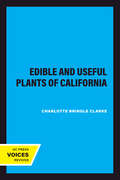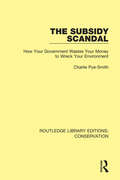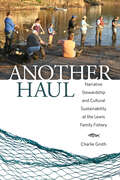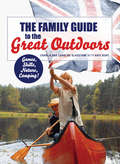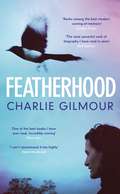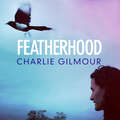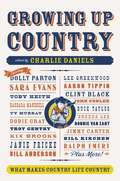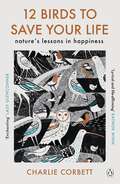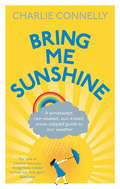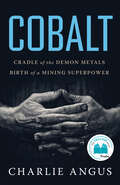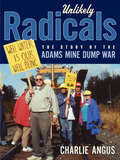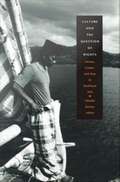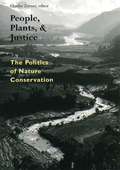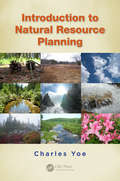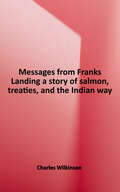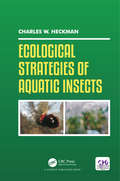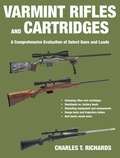- Table View
- List View
Recreational Vehicle Cookbook
by Charlotte DawsonIn her RECREATIONAL VEHICLE COOKBOOK Charlotte Dawson has collected some of the favorite recipes of fascinating people she and her husband have met on their travels throughout the United States. While most of the recipes lend themselves beautifully to recreational cooking because of their simplicity they are far from commonplace. Molasses pie, Sabattus stew, swamp cabbage, corn custard, Johnny Johnson's chili concoction and recipes from the Ladies' Auxiliary of the Hatteras Volunteer Fire Department are only a sampling of the many, many unusual recipes you will find between theese covers. Mrs. Dawson has organized her cookbook into regions of America. Represented are New England, the Middle Atlantic States, Southeast, Pacific Northwest and the Southwest. Also included are a host of recipes that are delicious just about everywhere.
Edible and Useful Plants of California (California Natural History Guides #41)
by Charlotte Bringle ClarkeBoth American Indians and the pioneers knew and used many different plant species-for food, fibers, medicine, tools, and other purposes. This unique book is a guide to identifying more than 220 such plants. But it goes much further-it also tells the reader how to prepare, cook, and otherwise use them. Some of the dishes for which recipes are given have won culinary prizes. All have been tested not only by the author but also by her students and by journalists-who have been uniformity surprised and impressed.The plants are organized by habitat communities. Description, photos, drawings, and distribution information are given. Where poisonous look-alikes exist, they too are illustrated. Much fascinating information about Indian uses of native and introduced species is included. The author emphasizes conservation considerations; the aim of the book is to educate the reader about intriguing uses of the plants, and to tell how to gather and use the most palatable and abundant species without damaging the environment.
The Subsidy Scandal: How Your Government Wastes Your Money to Wreck Your Environment (Routledge Library Editions: Conservation #7)
by Charlie Pye-SmithOriginally published in 2002, The Subsidy Scandal examines the subsidies spent by governments and the affect this has had on the environment. The book examines industries ranging from agriculture to mining, energy to transport and the subsidies spent on these industries by government. The book argues that these industries have had a negative impact on the environment, often funded through government subsidies derived from public taxes. The book suggests that these subsidies go to those who least need them – frequently to corporations and special interest groups which recycle some of the funds to support the politicians who keep the subsidies going. Based on research in North America, with examples from Europe and elsewhere, the book provides an investigative report into to the money assigned to environmental policies to find out where the money goes and what produces it.
Another Haul: Narrative Stewardship and Cultural Sustainability at the Lewis Family Fishery (Folklore Studies in a Multicultural World Series)
by Charlie GrothLewis Island in Lambertville, New Jersey, is the site of the Lewis Fishery, the last haul seine American shad fishery on the nontidal Delaware River. The Lewis family has fished in the same spot since 1888 and operated the fishery through five generations. The extended Lewis family, its fishery’s crew, and the Lambertville community connect with people throughout the region, including environmentalists concerned about the river. It was a Lewis who raised the alarm and helped resurrect a polluted river and its biosphere. While this once exclusively masculine activity is central to the tiny island, today men, women, and children fish, living out a sense of place, belonging, and sustainability.In Another Haul: Narrative Stewardship and Cultural Sustainability at the Lewis Family Fishery, author Charlie Groth highlights the traditional, vernacular, and everyday cultural expressions of the family and crew to understand how community, culture, and the environment intersect. Groth argues there is a system of narrative here that combines verbal activities and everyday activities.On the basis of over two decades of participation and observation, interviews, surveys, and a wide variety of published sources, Groth identifies a phenomenon she calls “narrative stewardship.” This narrative system, emphasizing place, community, and commitment, in turn, encourages environmental and cultural stewardship, tradition, and community. Intricate and embedded, the system appears invisible, but careful study unpacks and untangles how people, often unconsciously, foster sustainability. Though an ethnography of an occupation, the volume encourages readers to consider what arises as special about all cultures and what needs to be seen and preserved.
The Family Guide to the Great Outdoors
by Charlie GladstoneGetting outdoors brings the whole family together. You’ll learn skills, have a run-around, share laughs, and make enduring memories.This book is the perfect companion to any outdoor family adventure. From countryside camping holidays to weekends roaming fields and parks, it will inspire you to enjoy the outdoors whatever the weather. It covers everything for kids (and big kids) to do outdoors, including:- Cloud identification- Great British walks- Building dams and dens- Campfires and woods- Camping recipes- Common British trees
Featherhood: 'The best piece of nature writing since H is for Hawk, and the most powerful work of biography I have read in years' Neil Gaiman
by Charlie Gilmour'One of the best books I have ever read. Incredibly moving' Elton John'I cant recommend it too highly' Helen Macdonald'Ranks among the best modern coming-of-age memoirs' Sunday Times'Where Helen Macdonald's H Is For Hawk meets Gerald Durrell's My Family And Other Animals ... Remarkable' Daily Mail'Beautiful, wise, compassionate and powerful' Isabella TreeThis is a story about birds and fathers.About the young magpie that fell from its nest in a Bermondsey junkyard into Charlie Gilmour's life - and swiftly changed it. Demanding worms around the clock, riffling through his wallet, sharing his baths and roosting in his hair... About the jackdaw kept at a Cornish stately home by Heathcote Williams, anarchist, poet, magician, stealer of Christmas, and Charlie's biological father who vanished from his life in the dead of night.It is a story about repetition across generations and birds that run in the blood; about a terror of repeating the sins of the father and a desire to build a nest of one's own. It is a story about change - from wild to tame; from sanity to madness; from life to death to birth; from freedom to captivity and back again, via an insane asylum, a prison and a magpie's nest.And ultimately, it is the story of a love affair between a man and a magpie. 'An incisive, funny and at times traumatic study of the damage done by destructive father-son relationships and the struggle to smash generational cycles' Evening Standard'A personal reckoning which is simultaneously brutal and joyous. I was entranced' Cathy Rentzenbrink'A beautiful book - it made me cry' Simon Amstell
Featherhood: 'The best piece of nature writing since H is for Hawk, and the most powerful work of biography I have read in years' Neil Gaiman
by Charlie Gilmour'One of the best books I have ever read. Incredibly moving' Elton John'I cant recommend it too highly' Helen Macdonald'Ranks among the best modern coming-of-age memoirs' Sunday Times'Where Helen Macdonald's H Is For Hawk meets Gerald Durrell's My Family And Other Animals ... Remarkable' Daily Mail'Beautiful, wise, compassionate and powerful' Isabella TreeThis is a story about birds and fathers.About the young magpie that fell from its nest in a Bermondsey junkyard into Charlie Gilmour's life - and swiftly changed it. Demanding worms around the clock, riffling through his wallet, sharing his baths and roosting in his hair... About the jackdaw kept at a Cornish stately home by Heathcote Williams, anarchist, poet, magician, stealer of Christmas, and Charlie's biological father who vanished from his life in the dead of night.It is a story about repetition across generations and birds that run in the blood; about a terror of repeating the sins of the father and a desire to build a nest of one's own. It is a story about change - from wild to tame; from sanity to madness; from life to death to birth; from freedom to captivity and back again, via an insane asylum, a prison and a magpie's nest.And ultimately, it is the story of a love affair between a man and a magpie. 'An incisive, funny and at times traumatic study of the damage done by destructive father-son relationships and the struggle to smash generational cycles' Evening Standard'A personal reckoning which is simultaneously brutal and joyous. I was entranced' Cathy Rentzenbrink'A beautiful book - it made me cry' Simon Amstell
Love is a Cockapoo: A Dog-Tastic Celebration of the World's Cutest Breed
by Charlie EllisCockapoos are loyal, loving and intelligent, and they look just like teddy bears – what more could you want from a pup? What they lack in size, they make up for in curliness and cuddliness. Dedicated to the world’s favourite hybrid, this paw-some book will prove that it’s not just any old dog that’s man’s best friend – it’s a cockapoo.
Love is a Mutt: A Dog-Tastic Celebration of the World's Cutest Mixed and Cross Breeds
by Charlie EllisLife is better with a muttThis collection of adorable photos of mongrels, mutts and crossbreeds will have you head-over-paws in loveThe dogs within these pages may be a mix of breeds, but they’re pure of heart. Some are fluffy. Some are scruffy. Some are wire-haired. Some have velveteen fur or shiny locks. Whatever they look like, big or small, they’re almost definitely lovable, mischievous and full of joy.This little book is a celebration of crossbreeds and mutts the world over. What mongrels lack in pedigree they more than make up for in cuteness, loyalty and love. Whether you’ve got one, want one or just think they’re super-cute, these adorable pups are here to win your heart. Love is a Mutt will prove that home is where your pup is, and that it’s not just any old dog who deserves to be your best friend – it’s a mongrel.
Love is a Mutt: A Dog-Tastic Celebration of the World's Cutest Mixed and Cross Breeds
by Charlie EllisLife is better with a muttThis collection of adorable photos of mongrels, mutts and crossbreeds will have you head-over-paws in loveThe dogs within these pages may be a mix of breeds, but they’re pure of heart. Some are fluffy. Some are scruffy. Some are wire-haired. Some have velveteen fur or shiny locks. Whatever they look like, big or small, they’re almost definitely lovable, mischievous and full of joy.This little book is a celebration of crossbreeds and mutts the world over. What mongrels lack in pedigree they more than make up for in cuteness, loyalty and love. Whether you’ve got one, want one or just think they’re super-cute, these adorable pups are here to win your heart. Love is a Mutt will prove that home is where your pup is, and that it’s not just any old dog who deserves to be your best friend – it’s a mongrel.
Love is a Spaniel: A Dog-Tastic Celebration of the World’s Most Lovable Breed
by Charlie EllisLife is better with a spanielThis paw-some collection of delightful photos and wise words will have you swooning for spanielsWith their irresistible smiles, ears for years and endless amounts of energy, it’s no wonder spaniels are one of the world’s favourite dog breeds. Featuring the English cocker, Welsh springer, Cavalier King Charles and all spaniels in between, this little book is a celebration of the spaniel’s happy personality and majestic attitude. Whichever type is your favourite, these clever canines are always ready to demonstrate their love and loyalty.Our fondness for these pooches spans the globe, and whether you have a spaniel of your own or just think they’re the best pups in town, the adorable doggos in these pages will melt your heart and leave you feeling warm and fuzzy. This paw-some little book will prove that it’s not just any old dog who deserves to be your best friend – it’s a spaniel.
Growing Up Country: What Makes Country Life Country
by Charlie DanielsFrom Growing Up Country: "I learned early in life that country is not a place on a map. Country is a place in your heart. In your soul. In the very depth of your being." --Bill Anderson. "One of the things I like most about country life is that nothing much has really changed ... My grandchildren and I are still walking and hunting in the same woods and fishing in the same creeks as I did with my father." --President Jimmy Carter. "Food was at the heart of our home. And, other than those troublesome vegetables, I loved all of it. We fried everything--we'd have even fried water if we could've." --Keith Anderson. "I can't imagine what my life would have been without peaceful days, mountain streams, homegrown and home-cooked food, country church, and all-day singing with dinner on the grounds with family and friends." --Dolly Parton. "Growing up country--there's nothing like it. It's growing up with your grandmother and granddaddy around ... it's a lot of love when you need it, great cooking in the kitchen, and always being real." --Eddie Montgomery. Blackberry pie on the window ledge. The Grand Ole Opry on the radio. Sunday dinners on the table. Families swinging on the front porch after a hard day's work. It's all part of the country way of life. Here, legendary country music singer Charlie Daniels introduces and edits a collection of heartfelt essays from an all-star cast of contributors on what it means to grow up country. United by a love of music, these notables show us that country means more than just the twang of a guitar. They share a belief in hard work, integrity, strength of character, and having the courage not to quit. The stories here tell of rustic upbringings and rich spirits, of parents who believed in tough love and old-fashioned common sense, and of a strong sense of community, pride in your country, and a love of the natural world. You'll get an intimate glimpse into the lives of: Country music royalty and all-time greats such as Dolly Parton, Barbara Mandrell, Brenda Lee, Dobie Gray, and Lee Greenwood; Southern rock gods such as Gary Rossington and Donnie Van Zant; The newest crop of stars such as Sara Evans, Toby Keith, and Clint Black; Special guests such as former president Jimmy Carter, and seven-time all around rodeo champion Ty Murray. These snapshots show how living country has allowed our favorite singers, songwriters, and stage performers to make a career out of doing what they love while never forgetting that when you've grown up country, home isn't just a place where you live, it's a state of the heart.
12 Birds to Save Your Life: Nature's Lessons in Happiness
by Charlie CorbettDiscover the healing power of nature through the stories of these characterful birds, whose song is never far away . . .LONGLISTED FOR THE 2022 WAINWRIGHT PRIZE'A lyrical and life-affirming book that teaches us as much about birds as it does ourselves - a balm for the soul' Raynor Winn, author of The Salt Path'Totally absorbing and completely engaging on so many levels . . . Charlie has opened my eyes to the constant joy of the sights and sounds of the birds that surround us. It is a book that really will save lives' Dr Richard Shepherd, author of Unnatural Causes_________After the tragic loss of his mother, Charlie Corbett felt trapped by his pain. Having lost all hope and perspective he took to the countryside in search of solace. There, he heard the soaring, cascading song of the skylark - a sound that pulled him from the depths of despair and into the calm of the natural world.Weaving his journey through grief with a remarkable portrait of the birds living right on our doorstep, 12 Birds to Save Your Life is an invitation to stop, step outside, and listen. By following Charlie's path, opening your eyes and ears to what has been there all along, you will discover how nature can set you free.
Bring Me Sunshine: A Windswept, Rain-Soaked, Sun-Kissed, Snow-Capped Guide To Our Weather
by Charlie ConnellyWe talk about the weather a lot. It exasperates, confounds and on occasion delights us. Our national conversation is dominated by the weather, but how much do we really know about it? In Bring Me Sunshine, Charlie Connelly sets off on the trail of our island obsession. He breezes through the lives of meteorological eccentrics, geniuses, rainmakers and cloud-busters and brings vividly to life great weather events from history. He sheds light on Britain's weirdest wind, why we have the wettest place in England to thank for the trusty pencil, the debt that umbrella owners owe to Robinson Crusoe and why people once thought firing cannons at clouds was a great idea. Having adventured round the shipping forecast areas for his bestselling Attention All Shipping, Connelly is the perfect guide through a mélange of gales, blizzards, mists, heatwaves and the occasional shower of fish. By turns informative, entertaining and hilarious, Bring Me Sunshine answers all your weather questions as well as helping you to distinguish your graupel from your petrichor.
Cobalt: The Making of a Mining Superpower
by Charlie AngusThe world is desperate for cobalt. It drives the proliferation of digital and clean technologies. But this “demon metal” has a horrific present and a troubled history. The modern search for cobalt has brought investors back to a small town in Northern Canada, a place called Cobalt. Like the demon metal, this town has a dark and turbulent history. The tale of the early-twentieth-century mining rush at Cobalt has been told as a settler’s adventure, but Indigenous people had already been trading in metals from the region for two thousand years. And the events that happened here — the theft of Indigenous lands, the exploitation of a multicultural workforce, and the destruction of the natural environment — established a template for resource extraction that has been exported around the world. Charlie Angus reframes the complex and intersectional history of Cobalt within a broader international frame — from the conquistadores to the Western gold rush to the struggles in the Democratic Republic of Congo today. He demonstrates how Cobalt set Canada on its path to become the world’s dominant mining superpower.
Unlikely Radicals: The Story of the Adams Mine Dump War
by Charlie AngusFor twenty-two years politicians and businessmen pushed for the Adams Mine landfill as a solution to Ontario’s garbage disposal crisis. This plan to dump millions of tonnes of waste into the fractured pits of the Adams Mine prompted five separate civil resistance campaigns by a rural region of 35,000 in Northern Ontario. Unlikely Radicals traces the compelling history of the First Nations people and farmers, environmentalists and miners, retirees and volunteers, Anglophones and Francophones who stood side by side to defend their community with mass demonstrations, blockades, and non-violent resistance.
Culture and the Question of Rights: Forests, Coasts, and Seas in Southeast Asia
by Charles ZernerThis collection of ethnographic and interpretive essays fundamentally alters the debate over indigenous land claims in Southeast Asia and beyond. Based on fieldwork conducted in Malaysia and Indonesia during the 1980s and 1990s, these studies explore new terrain at the intersection of environmental justice, nature conservation, cultural performance, and the politics of making and interpreting claims. Calling for radical redefinitions of development and ownership and for new understandings of the translation of culture and rights in politically dangerous contexts--natural resource frontiers--this volume links social injustice and the degradation of Southeast Asian environments. Charles Zerner and his colleagues show how geographical areas once viewed as wild and undeveloped are actually cultural artifacts shaped by complex interactions with human societies. Drawing on richly varied sources of evidence and interpretation--from trance dances, court proceedings, tree planting patterns, marine and forest rituals, erotic poems, and codifications of customary law, Culture and the Question of Rights reveals the ironies, complexities, and histories of contemporary communities' struggles to retain their gardens, forests, fishing territories, and graveyards. The contributors examine how these cultural activities work to both construct and to lay claim to nature. These essays open up new avenues for negotiating indigenous rights against a background of violence, proliferating markets, and global ideas of biodiversity and threatened habitat. Contributors. Jane Atkinson, Don Brenneis, Stephanie Fried, Nancy Peluso, Marina Roseman, Anna Tsing, Charles Zerner
People, Plants, and Justice: The Politics of Nature Conservation
by Charles ZernerIn an era of market triumphalism, this book probes the social and environmental consequences of market-linked nature conservation schemes. Rather than supporting a new anti-market orthodoxy, Charles Zerner and colleagues assert that there is no universal entity, "the market." Analysis and remedies must be based on broader considerations of history, culture, and geography in order to establish meaningful and lasting changes in policy and practice.Original case studies from Asia, Latin America, Africa, and the South Pacific focus on topics as diverse as ecotourism, bioprospecting, oil extraction, cyanide fishing, timber extraction, and property rights. The cases position concerns about biodiversity conservation and resource management within social justice and legal perspectives, providing new insights for students, scholars, policy professionals and donor/foundations engaged in international conservation and social justice.
Introduction to Natural Resource Planning
by Charles YoeThis is an exciting time for natural resources planning. There are amazing technologies available to planners and a wide and growing array of resources, problems, and opportunities that need attention. Private and public interests are taking up these issues all over the world and at all levels of involvement. At the same time, inefficient planning
"DAWGS!": An Anthology of Stories About Them
by Charles Wright GrayShort story collection by famous authors such as D. H. Lawrence, Booth Tarkington, O. Henry, Albert Payson Terhune, Don Marquis and Max Brand, as well as less well-known. Stories show their times with some being violent and Definitely Not pc. Not for the tender hearted with the exception of 4 or so.
Bye-and-Bye: Selected Late Poems
by Charles WrightThe acclaimed collection by the Pulitzer Prize–winning poet whose work is “conceived in a manner that never ceased to astonish” (Helen Vendler, The New Republic).Over the course of nineteen collections of poems, former US Poet Laureate Charles Wright has built “one of the truly distinctive bodies of poetry created in the second half of the twentieth century” (David Young, Contemporary Poets).Bye-and-Bye, which brings together selections from Wright’s more recent volumes—including the entirety of Littlefoot, Wright’s moving, book-length meditation on mortality—showcases the themes and images that have defined his mature work: the true affinity between writer and subject, human and nature; the tenuous relationship between description and actuality; and the search for a truth that transcends change and death.Winner of the 2013 Bollingen Prize,. Bye-and-Bye is a wonderful introduction to the poetic vision of one of America’s finest and best-loved poets.
Messages from Frank's Landing: A Story of Salmon, Treaties, and the Indian Way
by Charles WilkinsonIn 1974 Federal Judge George H. Boldt issued one of the most sweeping rulings in the history of the Pacific Northwest, affirming the treaty rights of Northwest tribal fishermen and allocating to them 50 percent of the harvestable catch of salmon and steelhead. Among the Indians testifying in Judge Boldt’s courtroom were Nisqually tribal leader Billy Frank, Jr., and his 95-year-old father, whose six acres along the Nisqually River, known as Frank’s Landing, had been targeted for years by state game wardens in the so-called Fish Wars. <p><p>By the 1960s the Landing had become a focal point for the assertion of tribal treaty rights in the Northwest. It also lay at the moral center of the tribal sovereignty movement nationally. The confrontations at the Landing hit the news and caught the conscience of many. Like the schoolhouse steps at Little Rock or the bridge at Selma, Frank’s Landing came to signify a threshold for change, and Billy Frank, Jr., became a leading architect of consensus, a role he continues today as one of the most colorful and accomplished figures in the modern history of the Pacific Northwest. <p><p>In Messages from Frank’s Landing, Charles Wilkinson explores the broad historical, legal, and social context of Indian fishing rights in the Pacific Northwest, providing a dramatic account of the people and issues involved. He draws on his own decades of experience as a lawyer working with Indian people, and focuses throughout on Billy Frank and the river flowing past Frank’s Landing. In all aspects of Frank’s life as an activist, from legal settlements negotiated over salmon habitats destroyed by hydroelectric plants, to successful negotiations with the U.S. Army for environmental protection of tribal lands, Wilkinson points up the significance of the traditional Indian world view - the powerful and direct legacy of Frank’s father, conveyed through generations of Indian people who have crafted a practical working philosophy and a way of life. <p><p>Drawing on many hours spent talking and laughing with Billy Frank while canoeing the Nisqually watershed, Wilkinson conveys words of respect and responsibility for the earth we inhabit and for the diverse communities the world encompasses. These are the messages from Frank’s Landing. Wilkinson brings welcome clarity to complex legal issues, deepening our insight into a turbulent period in the political and environmental history of the Northwest.
Ecological Strategies of Aquatic Insects
by Charles W. HeckmanThis book recounts the habits of many interesting and unusual exceptions to the rule that insects are typically terrestrial forms of life. It examines the different ways that groups of species have developed modes of existence in or on the surface of water, and gives reasons why the gross morphology of insects is not favorable for life in or near bodies of water, such as wings that fail to function after coming into contact with water, rendering them useless.
Seaside Stroll
by Charles TrevinoGo on a snowy, sandy shore walk in a story where every single word starts with the letter S!Explore the beach in winter in this story told through clever language. During a sunset beach saunter, a girl stumbles and drops her doll into a tidal pool. Soaked! Celebrating the natural silence of an off-season location, the surf and sand are brought to life through this engaging story.
Varmint Rifles and Cartridges: A Comprehensive Evaluation of Select Guns and Loads
by Charles T. RichardsA thorough guide, Varmint Rifles and Cartridges provides detailed information about getting started in varmint hunting, selecting the best rifles for the job, and choosing your cartridges and other components. The text is supplemented by more than one hundred detailed photographs that illustrate the various types of rifles and cartridges available for varmint hunters.Varmint Rifles and Cartridges presents information about the history of varmint hunting and how those original rifles differ from the most popular rifles and cartridges available for varmint hunters on the market today. Each chapter of the book is dedicated to a particular cartridge, including the: .204 Ruger .223 Remington .220 Swift .243 Winchester .257 RobertsAt the end of each chapter, author C. T. Richards demonstrates how each cartridge and rifle performs through the results of range tests and trajectory tests he conducted himself. A varmint hunter since the 1950s, Richards is more than qualified to grade these products and offer advice on varmint hunting in general.The content of Varmint Rifles and Cartridges will appeal to readers considering varmint hunting for the first time, as well those who have previously acquired some experience in using these tools.

